Spatial Coupling of Carbon Sink Capacity with High-Quality Development Based on Exploitation and Protection Pattern
Abstract
1. Introduction
2. Theoretical Framework
2.1. The Logical Relationship between Carbon Sink Capacity and High-Quality Economic Development
2.2. System Construction of Carbon Sink Capacity and High-Quality Economic Development
3. General Situation and Data Sources of the Study Area
3.1. Study Area
3.2. Data Sources and Processing
4. Research Methods
4.1. Carbon Storage Identification Based on InVEST Model
4.2. Evaluation System and Calculation of Comprehensive Degree Index of Carbon Sink Land
4.2.1. Land-Use Classification of Carbon Sinks
4.2.2. Comprehensive Efficiency Index of Carbon Sequestration of Land Cover
4.3. Construction of Coupling Model between Carbon Sink Capacity and High-Quality Development
4.3.1. Evaluation Index Construction
4.3.2. Construction of Coupling Coordination Relationship Model
4.3.3. Relative Development Model
4.4. Geographic Detector Model
5. Result and Analysis
5.1. Temporal and Spatial Evolution Characteristics of Carbon Storage and Carbon Sequestration
5.1.1. Temporal and Spatial Evolution Characteristics of Carbon Storage and Carbon Sequestration
5.1.2. Temporal and Spatial Characteristics of Ecological Carbon Sinks
5.2. Comprehensive Function Evaluation and Coupling Coordination Analysis
5.2.1. Spatial Pattern of Carbon Sink Capacity and Comprehensive Index of High-Quality Development Level
5.2.2. Analysis of Coupling Coordination between Carbon Sink Capacity and High-Quality Development
5.3. Analysis of Influencing Factors
5.3.1. Single-Factor Detection
5.3.2. Interactive Factor Detection
5.3.3. Influence Mechanism Analysis
6. Recommendations
Author Contributions
Funding
Institutional Review Board Statement
Informed Consent Statement
Data Availability Statement
Conflicts of Interest
References
- Piao, S.; Huang, M.; Liu, Z. Lower land-use emissions responsible for increased net land carbon sink during the slow warming period. Nat. Geosci. 2018, 11, 739–743. [Google Scholar] [CrossRef]
- Sitch, S.; Friedlingstein, P.; Gruber, N.; Jones, S.D.; Murray-Tortarolo, G.; Ahlström, A. Recent trends and drivers of regional sources and sinks of carbon dioxide. Biogeosciences 2015, 12, 653–679. [Google Scholar] [CrossRef]
- Friedlingstein, P.; Cox, P.; Betts, R.; Bopp, L.; von Bloh, W.; Brovkin, V.; Cadule, P.; Doney, S.; Eby, M.; Fung, I.; et al. Climate–Carbon Cycle Feedback Analysis: Results from the C4MIP Model intercomparison. J. Clim. 2006, 19, 3337–3353. [Google Scholar] [CrossRef]
- Wang, J.; Feng, L.; Palmer, P.I. Large Chinese land carbon sink estimated from atmospheric carbon dioxide data. Nature 2020, 586, 720–723. [Google Scholar] [CrossRef]
- Tang, X.; Zhao, X.; Bai, Y.; Tang, Z. Carbon pools in China’s terrestrial ecosystems: New estimates based on an intensive field survey. Proc. Natl. Acad. Sci. USA 2018, 115, 4021–4026. [Google Scholar] [CrossRef]
- Jin, P. Study on the “High-Quality Development” Economics. China Econ. 2018, 4, 5–18. (In Chinese) [Google Scholar] [CrossRef]
- Pan, Y.; Richard, A.; Fang, B.; Richard, H.; Kauppi, P.E.; Kurz, W.A.; Phillips, O.L.; Shvidenko, A.; Lewis, S.L.; Canadell, J.G.; et al. Reducing food’s environmental impacts through producers and consumers. Science 2018, 360, 987–992. [Google Scholar]
- Xu, X.; Liu, J.; Jiao, F.; Zhang, K.; Ye, X.; Gong, H.; Lin, N.; Zou, C. Ecological Engineering Induced Carbon Sinks Shifting from Decreasing to Increasing during 1981–2019 in China. Sci. Total Environ. 2023, 864, 161037. [Google Scholar] [CrossRef]
- O’Sullivan, M.; Friedlingstein, P.; Sitch, S. Process-oriented analysis of dominant sources of uncertainty in the land carbon sink. Nat. Commun. 2022, 13, 4781. [Google Scholar] [CrossRef] [PubMed]
- Yu, Z.; Ciais, P.; Piao, S. Forest expansion dominates China’s land carbon sink since 1980. Nat. Commun. 2022, 13, 5374. [Google Scholar] [CrossRef]
- Chen, H.; Chen, Y.; Chen, X. Impacts of Historical Land Use Changes on Ecosystem Services in Guangdong Province, China. Land 2022, 11, 809. [Google Scholar] [CrossRef]
- Albaladejo, J.; Ortiz, R.; Garcia-Franco, N.; Navarro, A.R.; Almagro, M.; Pintado, J.G.; Martínez-Mena, M. Land use and climate change impacts on soil organic carbon stocks in semi-arid Spain. J. Soils Sediments 2013, 13, 265–277. [Google Scholar] [CrossRef]
- Pelletier, L.; Strachan, I.B.; Roulet, N.T.; Garneau, M.; Wischnewski, K. Effect of open water pools on ecosystem scale surface-atmosphere carbon dioxide exchange in a boreal peatland Biogeochemistry. Biogeochemistry 2015, 124, 291–304. [Google Scholar] [CrossRef]
- Chi, J.; Nilsson, M.B.; Laudon, H. The Net Landscape Carbon Balance—Integrating terrestrial and aquatic carbon fluxes in a managed boreal forest landscape in Sweden. Glob. Chang. Biol. 2020, 26, 2353–2367. [Google Scholar] [CrossRef]
- Chen, S.; Wang, W.; Xu, W.; Wang, Y. Plant diversity enhances productivity and soil carbon storage. Proc. Natl. Acad. Sci. USA 2018, 115, 4027–4032. [Google Scholar] [CrossRef]
- Liu, J.; Wang, Z.; Duan, Y.; Li, X.; Zhang, M.; Liu, H.; Xue, P.; Gong, H.; Wang, X.; Chen, Y.; et al. Effects of land use patterns on the interannual variations of carbon sinks of terrestrial ecosystems in China. Ecol. Indic. 2023, 146, 109914. [Google Scholar] [CrossRef]
- Bhagabati, N.K.; Ricketts, T.; Sulistyawan, T.B.S.; Conte, M.; Ennaanay, D.; Hadian, O.; McKenzie, E.; Olwero, N.; Rosenthal, A.; Tallis, H.; et al. Ecosystem services reinforce Sumatran tiger conservation in land use plans. Biol. Conserv. 2014, 169, 147–156. [Google Scholar] [CrossRef]
- Siarudin, M.; Rahman, S.A.; Artati, Y.; Indrajaya, Y.; Narulita, S.; Ardha, M.J.; Larjavaara, M. Carbon sequestration potential of agroforestry systems in degraded landscapes in West Java, Indonesia. Forests 2021, 12, 714. [Google Scholar] [CrossRef]
- Nag, S.K.; Ghosh, B.D.; Sarkar, U.K.; Das, B.K. An appraisal of carbon capture and sequestration in few selected wetlands of West Bengal. Environ. Dev. Sustain. 2023, 25, 1–16. [Google Scholar] [CrossRef]
- Hammad, H.M.; Nauman HM, F.; Abbas, F.; Ahmad, A.; Bakhat, H.F.; Saeed, S.; Shah, G.M.; Ahmad, A.; Cerdà, A. Carbon sequestration potential and soil characteristics of various land use systems in arid region. J. Environ. Manag. 2020, 264, 110254. [Google Scholar] [CrossRef]
- Chen, L.; Huo, C. The Measurement and Influencing Factors of High-Quality Economic Development in China. Sustainability 2022, 14, 9293. [Google Scholar] [CrossRef]
- Wei, M.; Li, S.H. Study on the Measurement of Economic High-Quality Development Level in China in the New Era. J. Quant. Tech. Econ. 2018, 35, 3–20. (In Chinese) [Google Scholar]
- Zhang, Y.; Li, W.; Sun, J.; Zhao, H.; Lin, H. A Research Paradigm for Industrial Spatial Layout Optimization and High-Quality Development in the Context of Carbon Peaking. Sustainability 2023, 15, 3105. [Google Scholar] [CrossRef]
- Zhang, Z.; Wan, X.; Sheng, K.; Sun, H.; Jia, L.; Peng, J. Impact of Carbon Sequestration by Terrestrial Vegetation on Economic Growth: Evidence from Chinese County Satellite Data. Sustainability 2023, 15, 1369. [Google Scholar] [CrossRef]
- Lu, Z.; Wu, Y.; An, S.; Zhang, Y.; Zhu, J. The Measurement and Spatiotemporal Evolution Analysis of an Ecological Niche for the High-Quality Development of Resource-Based Cities in China. Sustainability 2022, 14, 12846. [Google Scholar] [CrossRef]
- Liang, Y.; Hashimoto, S.; Liu, L. Integrated assessment of land-use/land-cover dynamics on carbon storage services in the Loess Plateau of China from 1995 to 2050. Ecol. Indic. 2020, 120, 106939. [Google Scholar] [CrossRef]
- Yu, G.R. Promote the Doubling of Ecological Carbon Sinks and Strengthen the “Double Carbon” Strategy as “Ballast Stone”. 2022. Available online: https://wap.sciencenet.cn/mobile.php?type=detail&cat=news&id=483105&mobile=1 (accessed on 13 November 2022).
- Nelson, E.J.; Daily, G.C. Modelling ecosystem services in terrestrial systems. F1000 Biol. Rep. 2010, 2, 53. [Google Scholar] [CrossRef] [PubMed]
- Selin, N.E. “Carbon Sequestration”. Encyclopedia Britannica. 21 April 2023. Available online: https://www.britannica.com/technology/carbon-sequestration (accessed on 23 April 2023).
- Leh, M.D.K.; Matlock, M.D.; Cummings, E.C.; Nalley, L.L. Quantifying and mapping multiple ecosystem services change in West Africa Agric. Ecosyst. Environ. 2013, 165, 6–18. [Google Scholar] [CrossRef]
- Zhao, M.; He, Z.; Du, J.; Chen, L.; Lin, P.; Fang, S. Assessing the Effects of Ecological Engineering on Carbon Storage by Linking the Ca-Markov and Invest Models. Ecol. Indic. 2019, 98, 29–38. [Google Scholar] [CrossRef]
- Dong, L.; Sun, Y.; Ran, J. Ecosystem organic carbon storage and their drivers across the drylands of China. Catena 2022, 214, 106280. [Google Scholar] [CrossRef]
- Cui, J.X.; Gu, J.; Sun, J.W.; Luo, J. The Spatial Pattern and Evolution Characteristics of the Production, Living and Ecological Space in Hubei Provence. China Land Sci. 2018, 32, 67–73. (In Chinese) [Google Scholar]
- Ni, W.Q.; Xia, Y.; Zhao, N.N. Functional Evolution and Coupling Coordination Measurement ofProduction-Living-Ecological Space in Rural Areas: Taking Heilongjiang Province as an Example. China Land Sci. 2022, 36, 111–119. (In Chinese) [Google Scholar]
- Jiang, H.; Zhang, W.; Yu, J.; Zhang, J. Spatial coupling of innovative milieu and industrial structure transformation of resource-based cities in Shanxi Province. J. Nat. Resour. 2020, 35, 269–283. [Google Scholar]
- Xue, M. The spatial and temporal pattern of coupling and coordination between economic development and ecological environment in the Yellow River Basin. World Reg. Stud. 2022, 31, 1261–1272. [Google Scholar]
- Zhang, X.; Brandt, M.; Tong, X. A large but transient carbon sink from urbanization and rural depopulation in China. Nat. Sustain. 2022, 5, 321–328. [Google Scholar] [CrossRef]
- Wang, J.; Xu, C. Geodetector: Principle and Prospective. Acta Geogr. Sin. 2017, 72, 116–134. [Google Scholar]
- Hou, R.; Li, H. Spatial-Temporal Change and Coupling Coordination Characteristics of LandUse Functions in Wuhan City: Based on the Comparison Before and after the “Resource-economical and Environment-friendly Society” Experimental Zone Establishment. China Land Sci. 2021, 35, 10. [Google Scholar]
- Wang, K.; Piao, S.; He, Y.; Liu, Y.; He, H. Spatial variations and mechanisms for the stability of terrestrial carbon sink in China. Sci. China Earth Sci. 2023, 66, 227–236. [Google Scholar] [CrossRef]
- Herman, G.V.; Caciora, T.; Ilies, D.C.; Ilies, A.; Deac, A.; Sturza, A.; Sonko, S.M.; Suba, N.S.; Nistor, S. 3D Modeling of the Cultural Heritage: Between Opportunity and Necessity. J. Appl. Eng. Sci. 2020, 10, 27–30. [Google Scholar] [CrossRef]
- Dong, X.; Qu, L.; Dong, G. Mowing mitigated the sensitivity of ecosystem carbon fluxes responses to heat waves in a Eurasian meadow steppe. Sci. Total Environ. 2022, 853, 158610. [Google Scholar] [CrossRef]
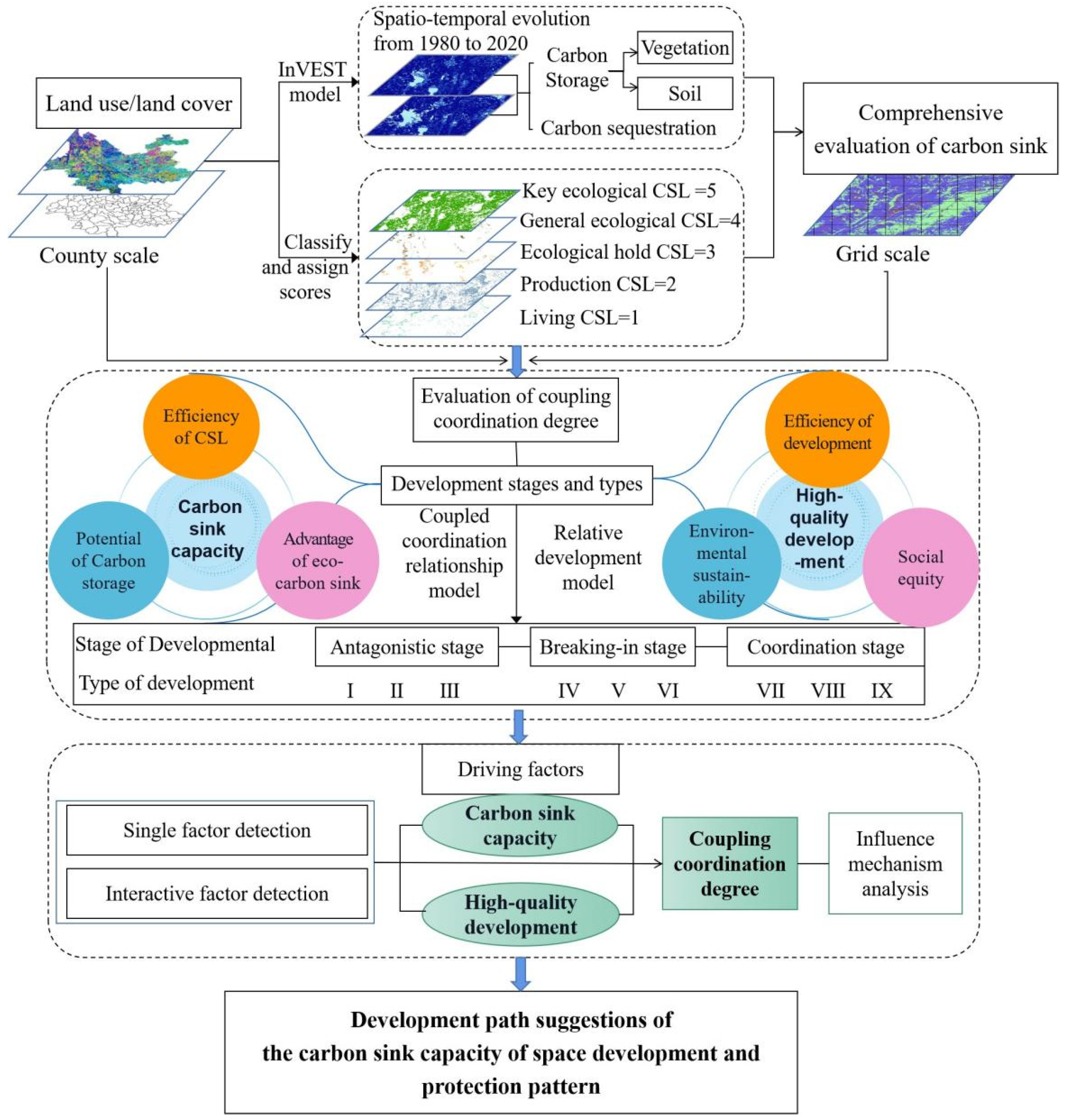
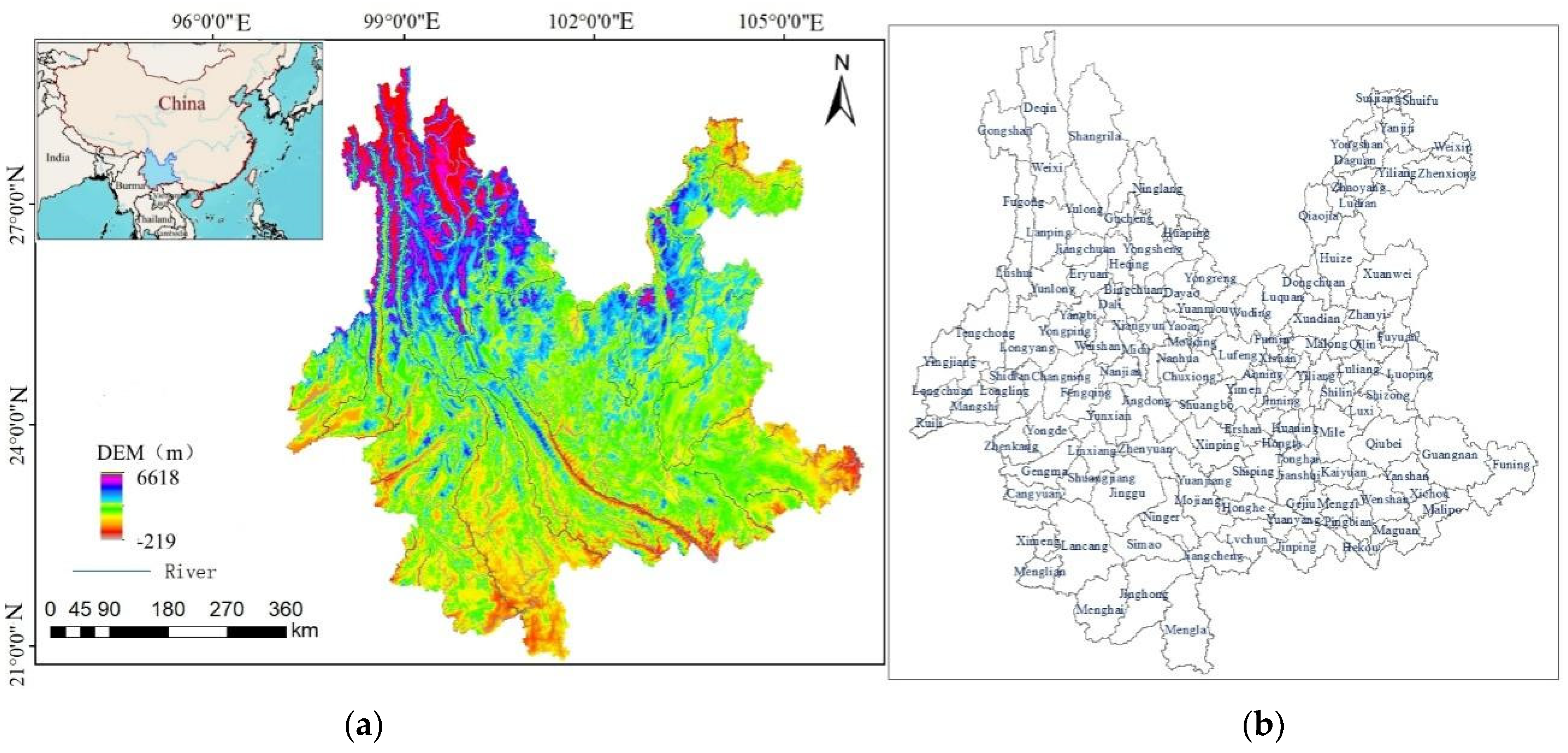
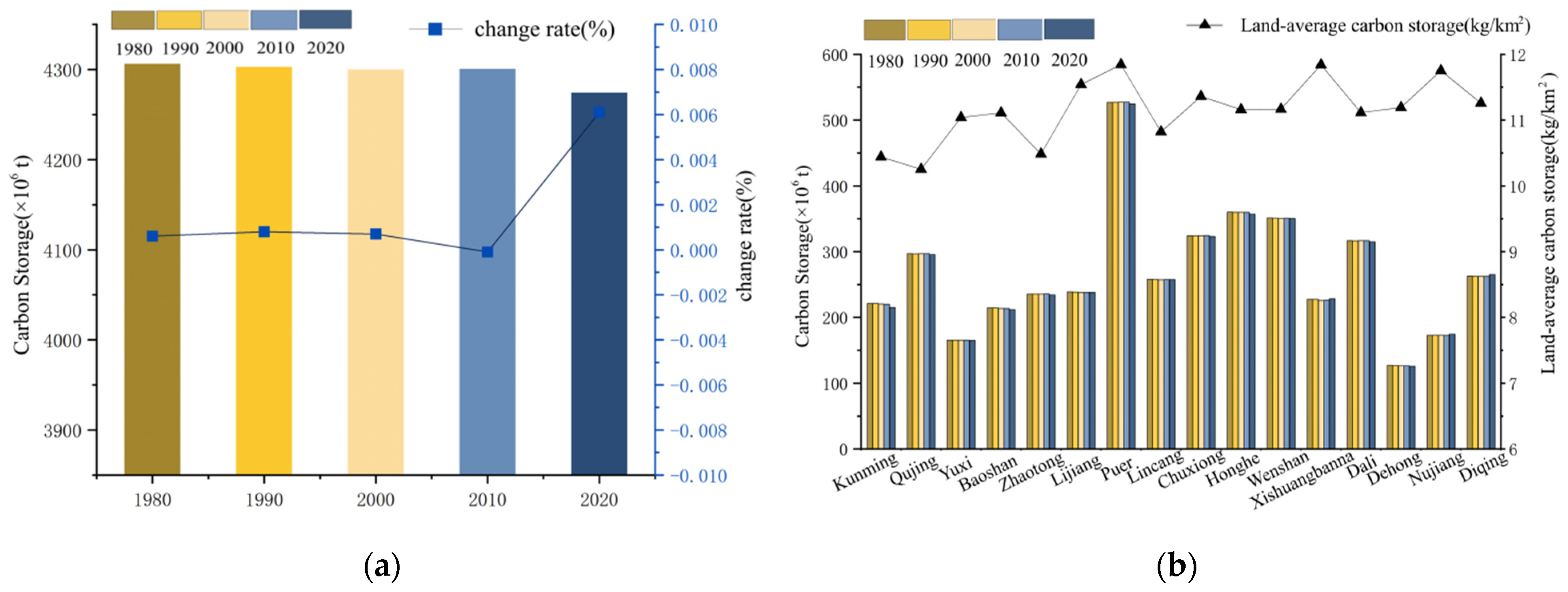
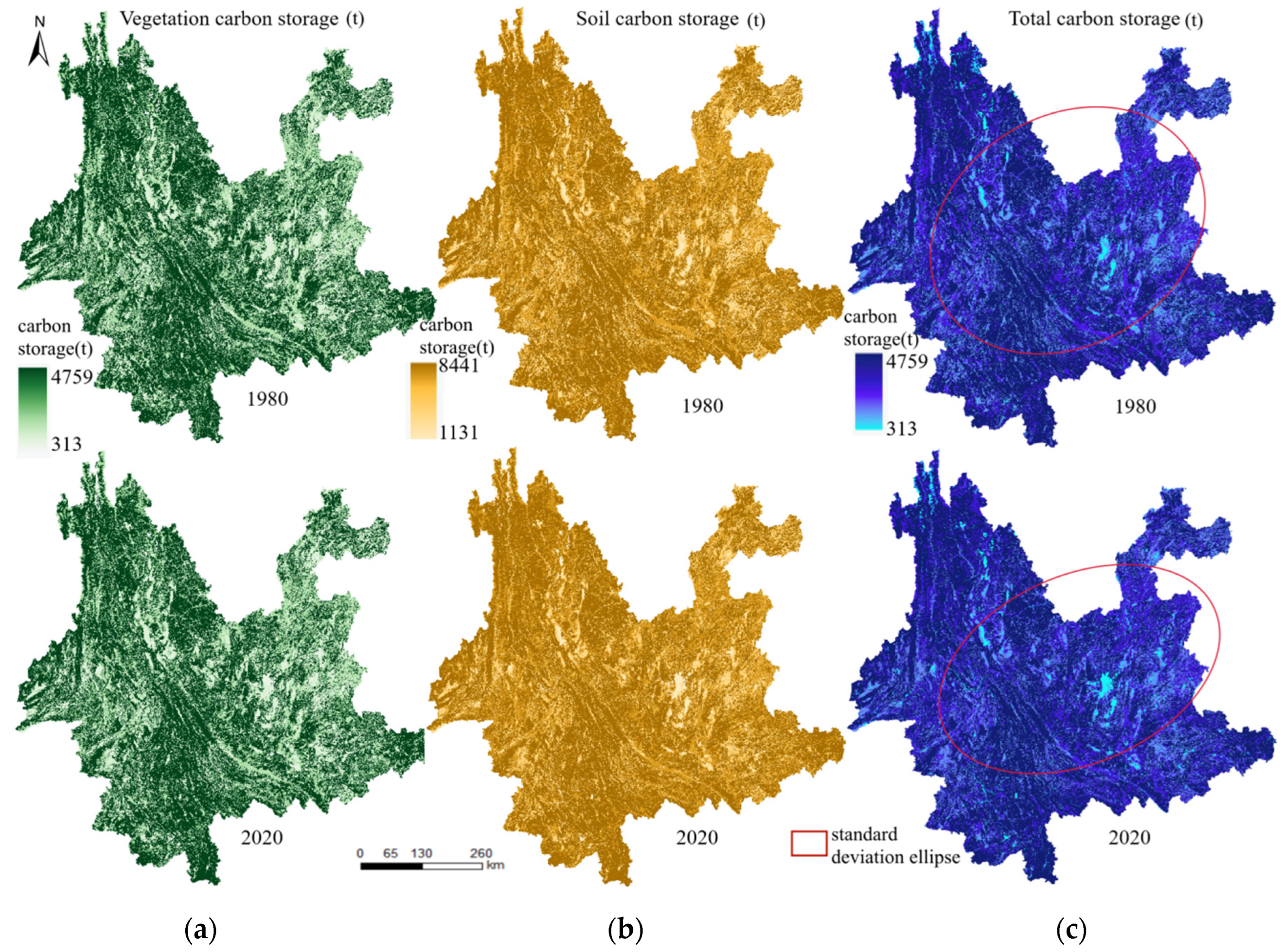
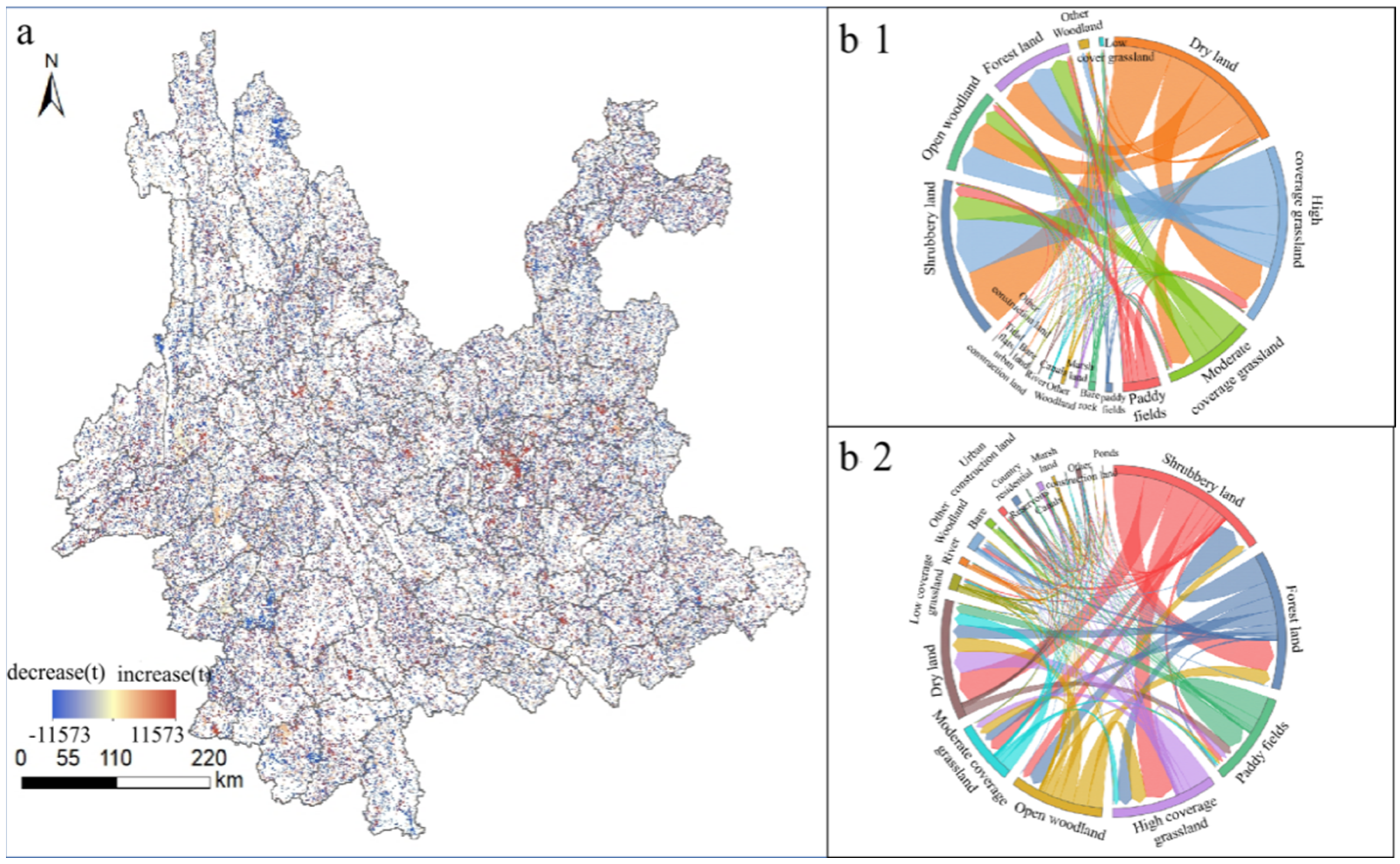
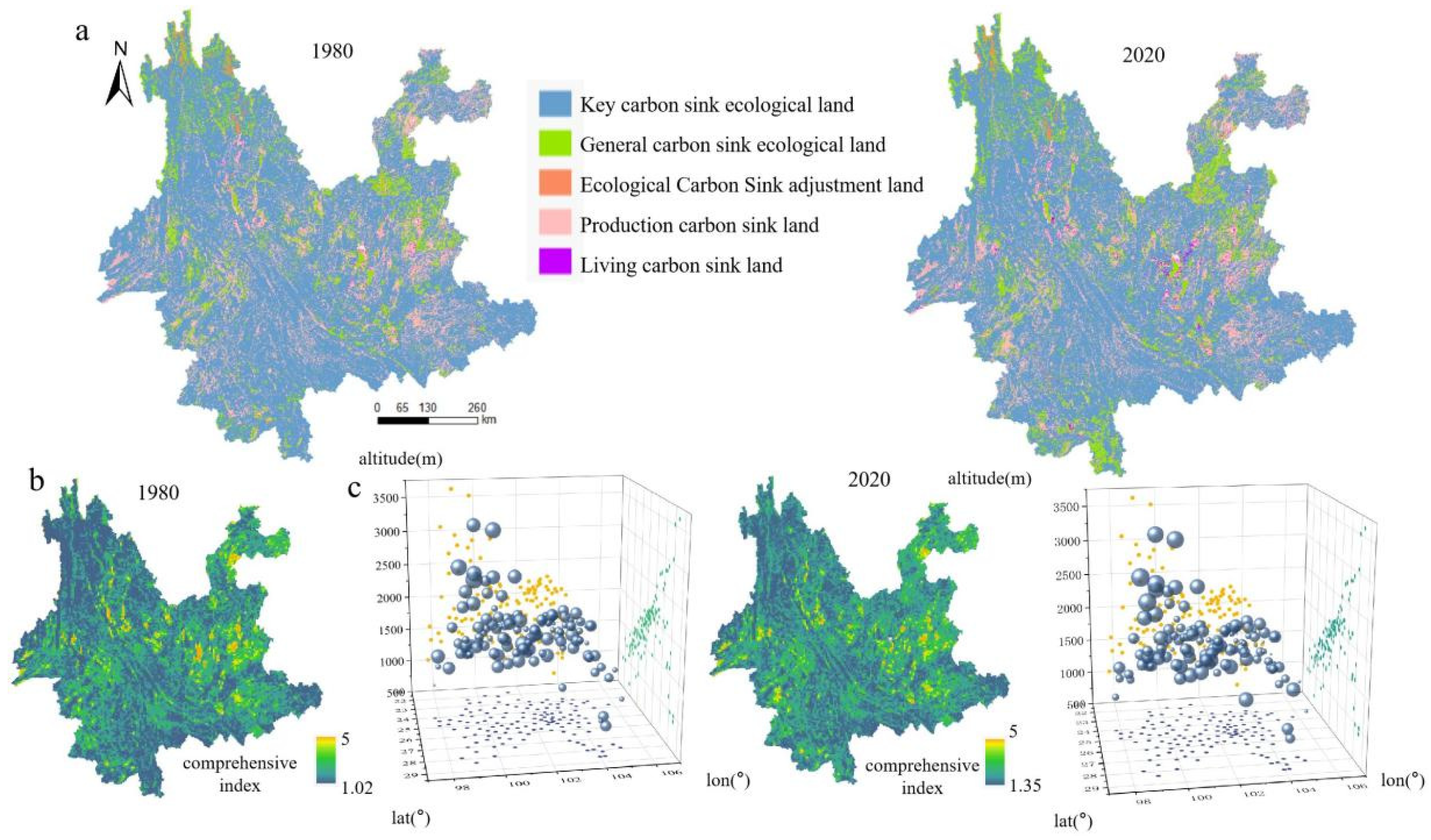
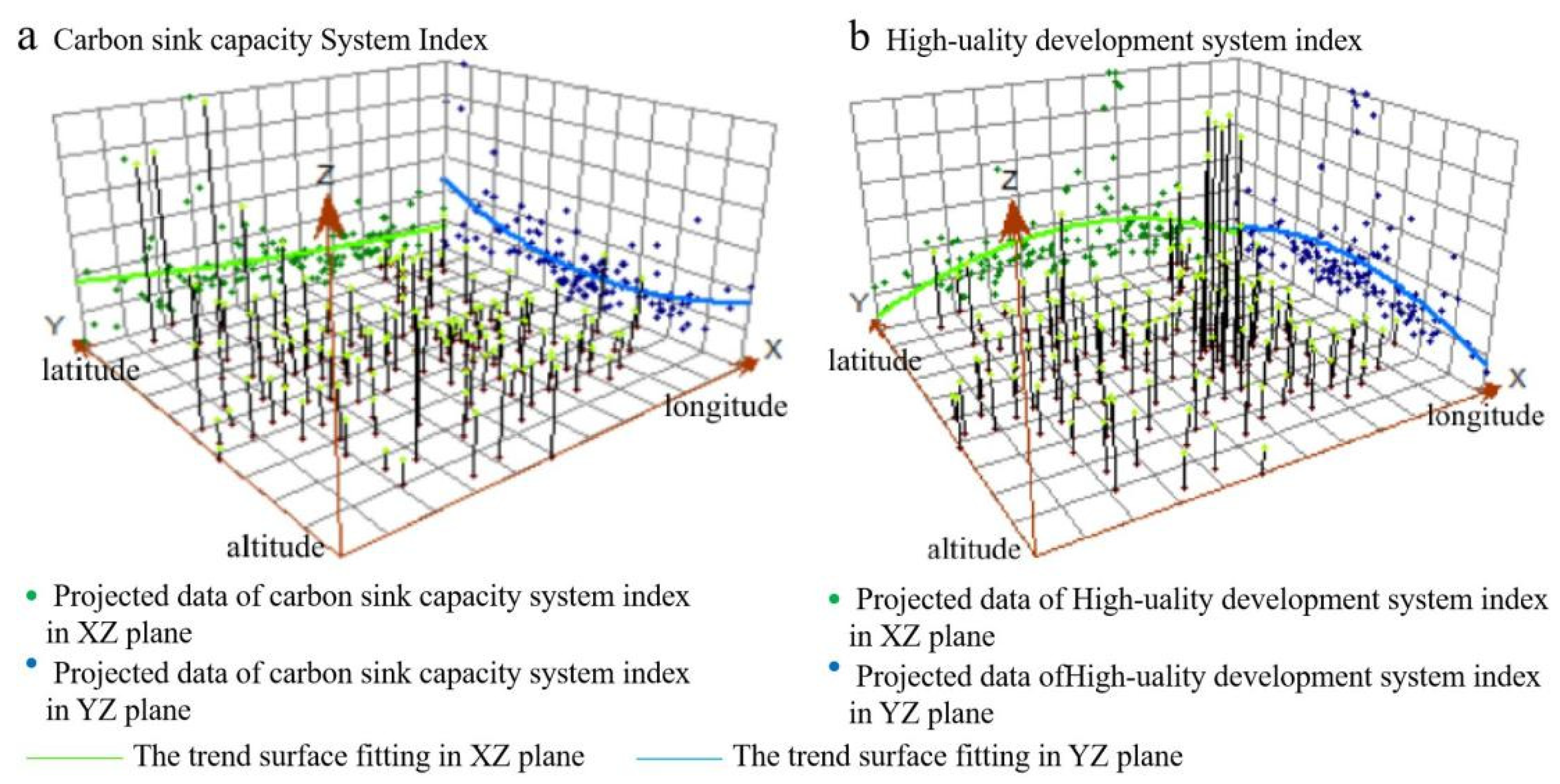
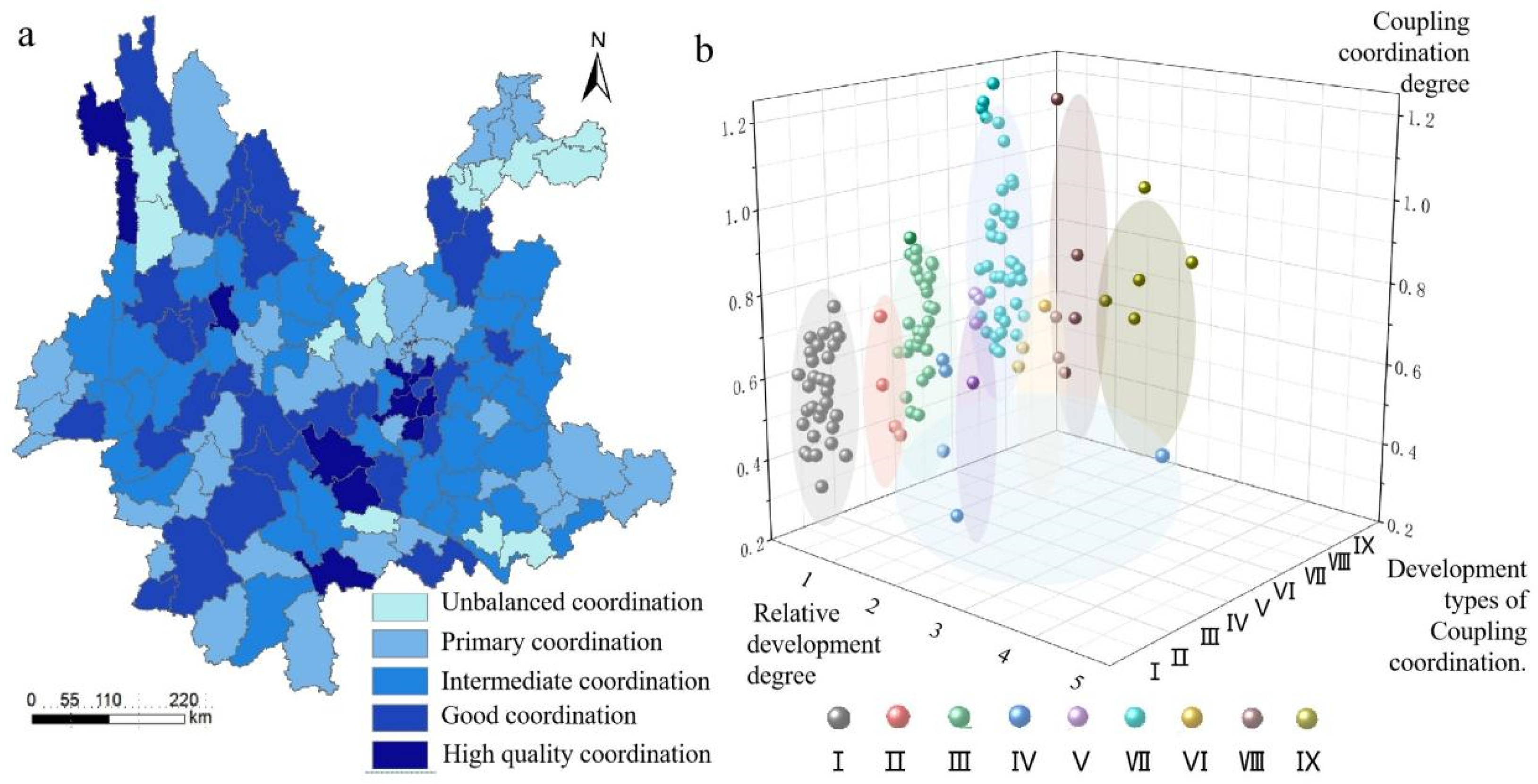

| Land-Use/Land-Cover Type | Cabove | Cbelow | Csoil | Cdead |
|---|---|---|---|---|
| Cultivated land | 7.99 | 3.4 | 64.18 | 0.19 |
| Woodland | 35.2 | 12.39 | 81.85 | 2.56 |
| Grassland | 7 | 12.76 | 74.56 | 3.73 |
| Water | 5.11 | 5.81 | 11.26 | 0.05 |
| Urban and rural built-land | 4.25 | 2.98 | 13.68 | 0.1 |
| Unused land | 2.51 | 0.62 | 12.94 | 0.2 |
| Main Categories | Secondary Categories | Function Scores of Carbon Sink | Land Use/land Cover Type (Primary) | Land Use/Land Cover Type (Secondary) | Value Orientation |
|---|---|---|---|---|---|
| Ecological land | Key carbon sink ecological land | 5 | Woodland | Shrubbery land | Ecological service value + carbon sink trading value |
| Open woodland | |||||
| Forest land | |||||
| Grassland | High-coverage grassland | ||||
| Unused land | Marsh land | ||||
| General carbon sink ecological land | 4 | Woodland | Other Woodland | Ecological service value | |
| Grassland | Moderate coverage grassland | ||||
| Low-coverage grassland | |||||
| Water | River | ||||
| Ecological carbon sink hold land | 3 | Water | Canals, reservoirs, ponds, tidal flats, permanent glaciers and snowfields | Ecological hold value | |
| Unused land | Sand, saline-alkali land, bare land, Gobi, Alpine desert, Tundra | ||||
| production space | Production carbon sink land | 2 | Cultivated land | paddy fields | Carbon neutrality value in agriculture |
| Dry land | |||||
| living space | Living carbon sink land. | 1 | Urban and rural, industrial and mining, residential land | Country residential | Urban and rural ecological value |
| Other construction land |
| Primary System | Subsystem (Index Weight) | Indicator Layer | Unit | Mean | Nature | Index Weight |
|---|---|---|---|---|---|---|
| Carbon sink capacity | Efficiency of CSL 0.374 | Carbon fixation degree of CSL | \ | Formula (4) | + | 0.374 |
| Potential of Carbon storage 0.291 | Total carbon storage | % | Total area carbon storage | + | 0.002 | |
| Proportion of added value of carbon storage | % | Increase in carbon storage /total carbon storage in the region | + | 0.037 | ||
| Proportion of carbon storage reduction value | % | Reduction in carbon storage/total carbon storage in the region | - | 0.103 | ||
| Average land carbon storage density | % | Carbon storage/total area | + | 0.108 | ||
| Advantage of ecological carbon sink 0.335 | Ecological dominance of carbon storage | % | High-carbon storage land area/total area | + | 0.142 | |
| Per capita ecological CSL area | km² | Ecological CSL area/total population | - | 0.218 | ||
| High-quality development | Efficiency of land use and exploitation 0.562 | Spatial exploitation intensity | km² | Construction land area/total area | - | 0.131 |
| Rate of increase in fixed capital investment | % | [(regional fixed assets investment in the current year/fixed assets investment in the previous year) − 1] × 100 | + | 0.153 | ||
| Output value of construction land per unit | Yuan | Total GDP/construction land area | + | 0.085 | ||
| Carbon intensity | t | Carbon emission quantity (carbon stock reduction)/gross regional product | - | 0.096 | ||
| Proportion of total output value of agriculture, forestry, animal husbandry and fishery | million yuan | Gross output value of agriculture, forestry, animal husbandry and fishery/gross regional product | + | 0.021 | ||
| Proportion of value added of primary industry | % | Value added of primary industry/gross regional product | + | 0.022 | ||
| Proportion of added value of secondary and tertiary industries | % | Added value of secondary and tertiary industries/gross regional product | + | 0.054 | ||
| Environmental sustainability 0.272 | Forest coverage rate | % | Forest area/total area | + | 0.169 | |
| Water area coverage | % | Water area/total area | + | 0.061 | ||
| Grassland coverage | % | Grassland area/total area | + | 0.042 | ||
| Social equity 0.166 | Urban–rural income ratio | % | Per capita disposable income of rural residents/per capita disposable income of urban residents | + | 0.021 | |
| Per capita revenue and expenditure ratio of local general public budget | Yuan | Per capita local general public budget revenue/per capita local general public budget expenditure | + | 0.063 | ||
| Per capita savings deposit level | Yuan per capita | savings surplus/Regional total population | + | 0.082 |
| Degree of Coupling Coordination Development | Relative Development Degree | Type | Coupling Coordinated Development Type Characteristics | Development Phase | Counties |
|---|---|---|---|---|---|
| 0 ≤ D ≤ 0.35 | 0 < P ≤ 0.8 | I | The carbon sink function lags behind the high-quality development and restricts the high-quality development, the ecological carbon sink capacity is weak, and the system tends to decline. | Antagonistic stage | Wuhua, Shuifu, Hongta, Suijiang, Ruili City, Lianghe, Ximeng, Xichou, Weixin, Fumin, Midu, Luxi, Mouding, Ludian, Daguan, Yanchin, Zhaoyang, Pingbian, Yun County, Honghe, Cangyuan, Yiliang, Shuangjiang, Yuanyang, Maguan, Lufeng, Xundian, Yongshan, Lvchun, Linxiang, Wu Ding xian |
| 0.8 < P < 1.2 | II | The carbon sink function synchronizes high-quality development and promotes high-quality development, the ecological carbon sink capacity is enhanced, and the system tends to be optimized. | Chuxiong, Funing, Lanping, Weixi | ||
| 1.2 ≤ P | III | The carbon sink function is ahead of the high-quality development, which affects the high-quality development, the high-quality development lags behind, and the system tends to be degraded. | Yingjiang, Mengla, Guangnan, Zhenxiong, Shangri-La | ||
| 0.35 < D < 0.5 | 0 < P ≤ 0.8 | IV | The carbon sink function lags behind the high-quality development and restricts the high-quality development, the ecological carbon sink capacity is weak and the system tends to decline. | Breaking-in stage | Anning, Songming, Malone, Shidian, Longchuan, Shilin, Huaping, Yao ‘an, Eryuan, Weishan, Luoping, Heqing, Mengzi, Jianchuan, Zhenkang, Eshan, Shizong, Nanhua, Wenshan, Malipo, Longling, Yun, Yanshan, Simao, Fuyuan, Meili, Gengma, Changning |
| 0.8 < P < 1.2 | V | The carbon sink function synchronizes high-quality development and promotes high-quality development, the ecological carbon sink capacity is enhanced, and the system tends to be optimized. | Menghai, Tengchong, Xuanwei, Qiubei, Mojiang | ||
| 1.2 ≤ P | VI | The carbon sink function is ahead of the high-quality development, which affects the high-quality development, the high-quality development lags behind, and the system tends to be degraded. | Lushui, Luquan, Longyang | ||
| 0.5 ≤ D ≤ 1 | 0 < P ≤ 0.8 | VII | The carbon sink function lags behind the high-quality development and restricts the high-quality development, the ecological carbon sink capacity is weak, and the system tends to decline. | Coordination stage | Panlong, Chenggong, Guandu, Chengjiang, Tonghai, Xishan, Jiangchuan, Qilin District, Hekou, Menglian, Yuanjiang, Huating, Dali, Luliang, Yimen |
| 0.8 < P < 1.2 | VIII | The carbon sink function synchronizes high-quality development and promotes high-quality development, the ecological carbon sink capacity is enhanced, and the system tends to be optimized. | Dayao, Fugong, Yongsheng, Jinghong, Ninglang, Huize | ||
| 1.2 ≤ P | IX | The carbon sink function is ahead of the high-quality development, which affects the high-quality development, the high-quality development lags behind, and the system tends to be degraded. | Jinggu, Lancang, Yulong, Gongshan, Deqin |
| Comprehensive Index of Carbon Sink Capacity | Comprehensive Index of High-Quality Development | Coupling Coordination Degree | ||||||
|---|---|---|---|---|---|---|---|---|
| Factor Sorting | q | p | Factor Sorting | q | p | Factor Sorting | q | p |
| X1 | 0.013 | 0.554 * | X9 | 0.016 | 0.405 * | X9 | 0.054 | 0.315 |
| X6 | 0.001 | 0.503 * | X5 | 0.087 | 0.369 | X10 | 0.019 | 0.250 * |
| X2 | 0.028 | 0.410 * | X8 | 0.029 | 0.354 * | X4 | 0.041 | 0.247 * |
| X7 | 0.083 | 0.345 | X1 | 0.018 | 0.343 * | X12 | 0.059 | 0.186 |
| X8 | 0.042 | 0.223 * | X10 | 0.088 | 0.272 | X2 | 0.014 | 0.123 * |
Disclaimer/Publisher’s Note: The statements, opinions and data contained in all publications are solely those of the individual author(s) and contributor(s) and not of MDPI and/or the editor(s). MDPI and/or the editor(s) disclaim responsibility for any injury to people or property resulting from any ideas, methods, instructions or products referred to in the content. |
© 2023 by the authors. Licensee MDPI, Basel, Switzerland. This article is an open access article distributed under the terms and conditions of the Creative Commons Attribution (CC BY) license (https://creativecommons.org/licenses/by/4.0/).
Share and Cite
Wang, L.; Zhao, J.; Li, F.; Chen, G. Spatial Coupling of Carbon Sink Capacity with High-Quality Development Based on Exploitation and Protection Pattern. Sustainability 2023, 15, 8108. https://doi.org/10.3390/su15108108
Wang L, Zhao J, Li F, Chen G. Spatial Coupling of Carbon Sink Capacity with High-Quality Development Based on Exploitation and Protection Pattern. Sustainability. 2023; 15(10):8108. https://doi.org/10.3390/su15108108
Chicago/Turabian StyleWang, Lin, Junsan Zhao, Fengxia Li, and Guoping Chen. 2023. "Spatial Coupling of Carbon Sink Capacity with High-Quality Development Based on Exploitation and Protection Pattern" Sustainability 15, no. 10: 8108. https://doi.org/10.3390/su15108108
APA StyleWang, L., Zhao, J., Li, F., & Chen, G. (2023). Spatial Coupling of Carbon Sink Capacity with High-Quality Development Based on Exploitation and Protection Pattern. Sustainability, 15(10), 8108. https://doi.org/10.3390/su15108108





